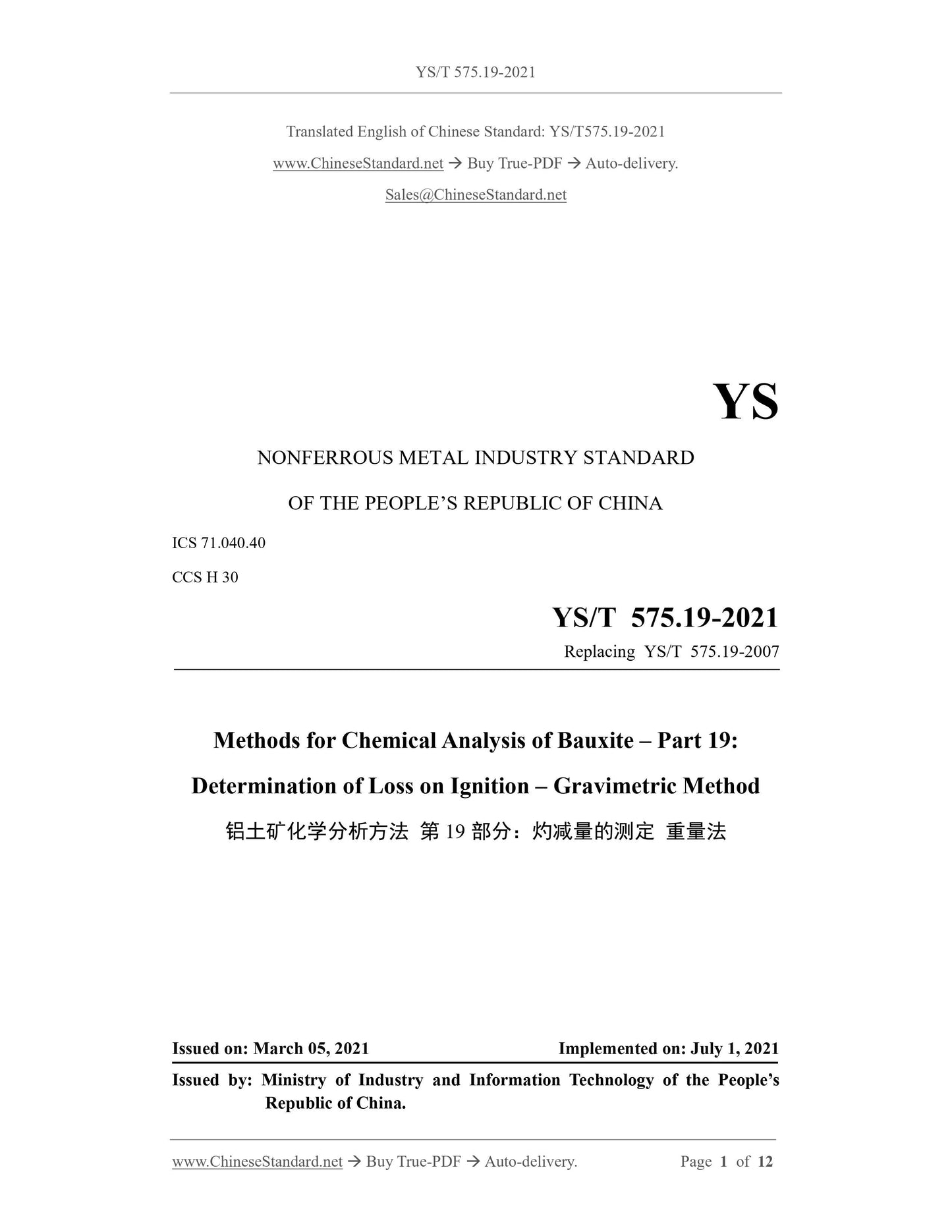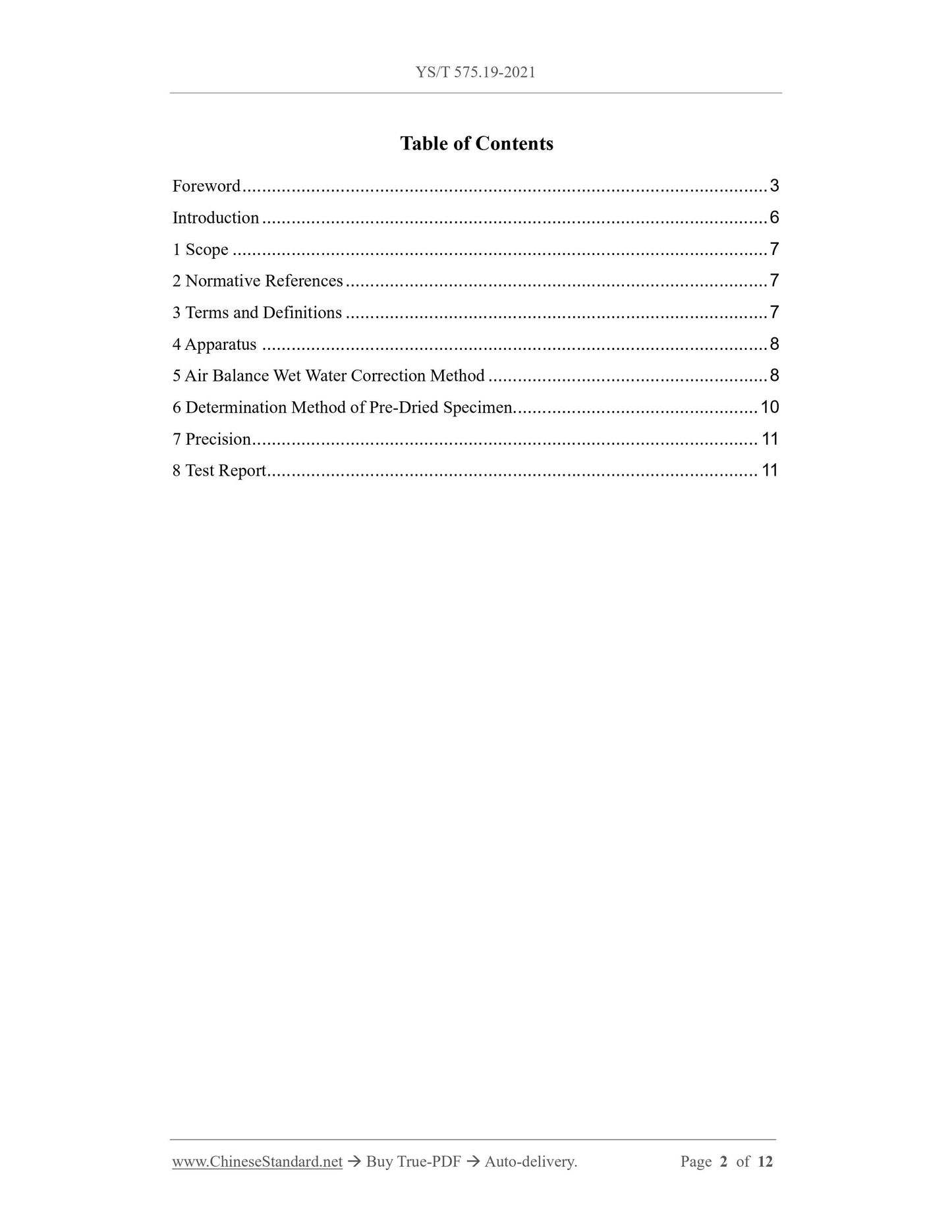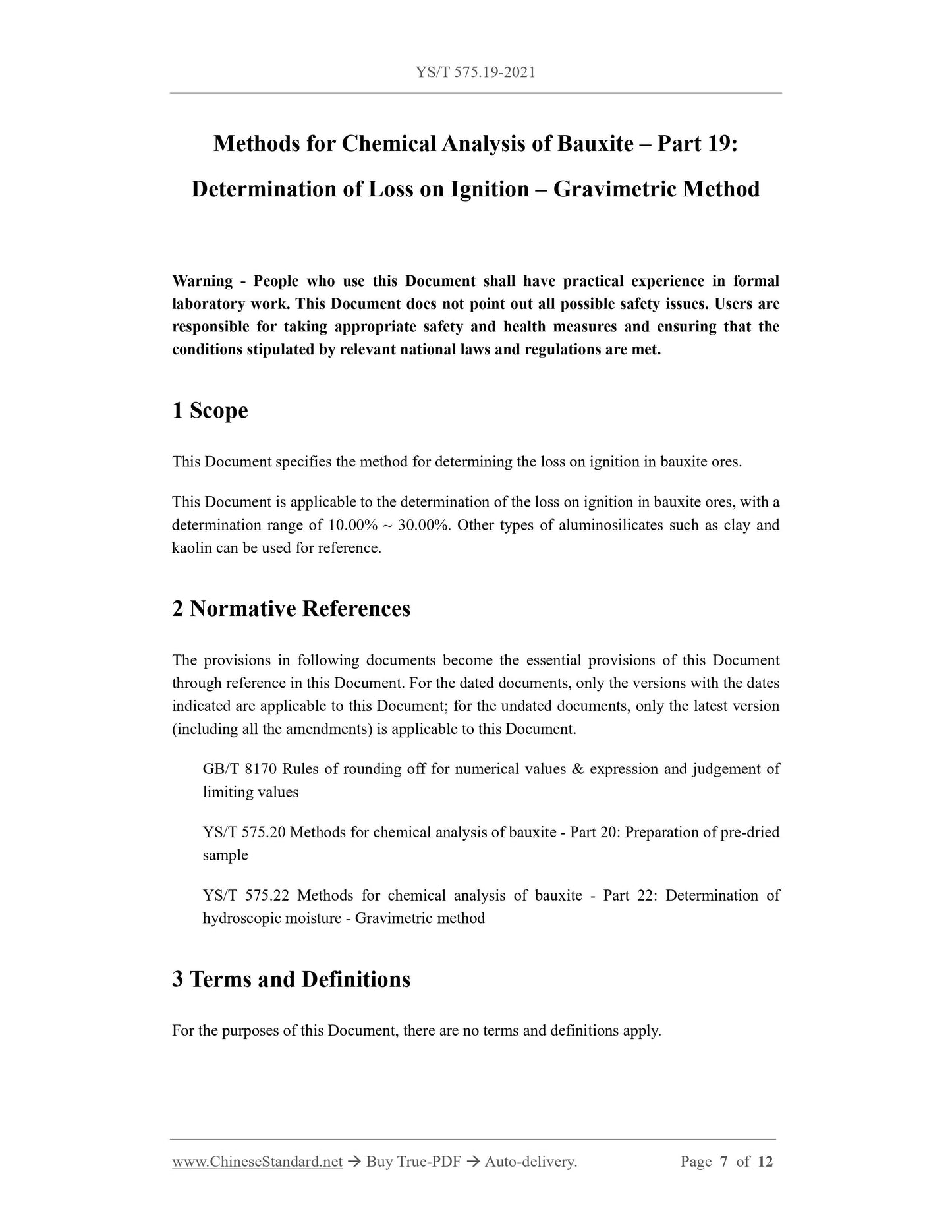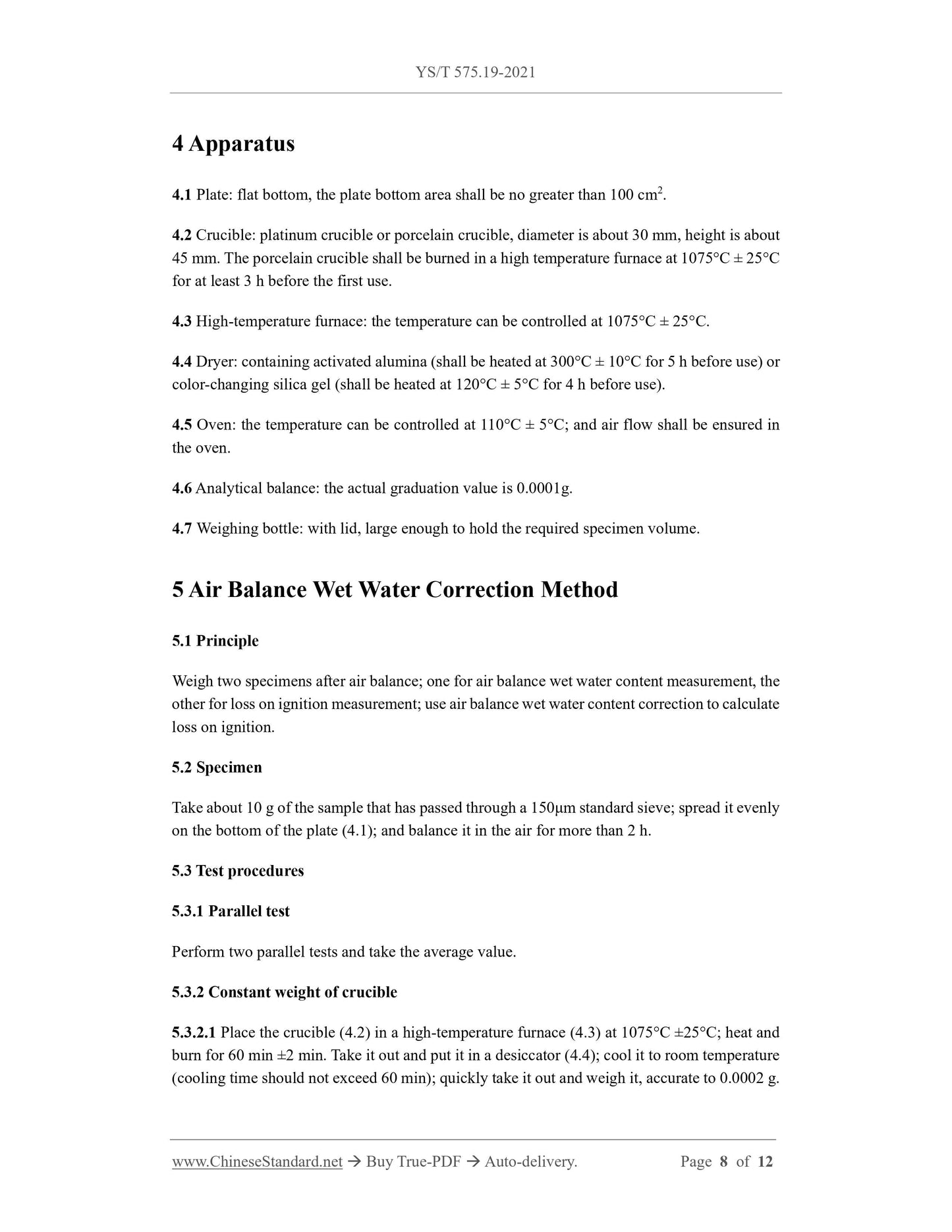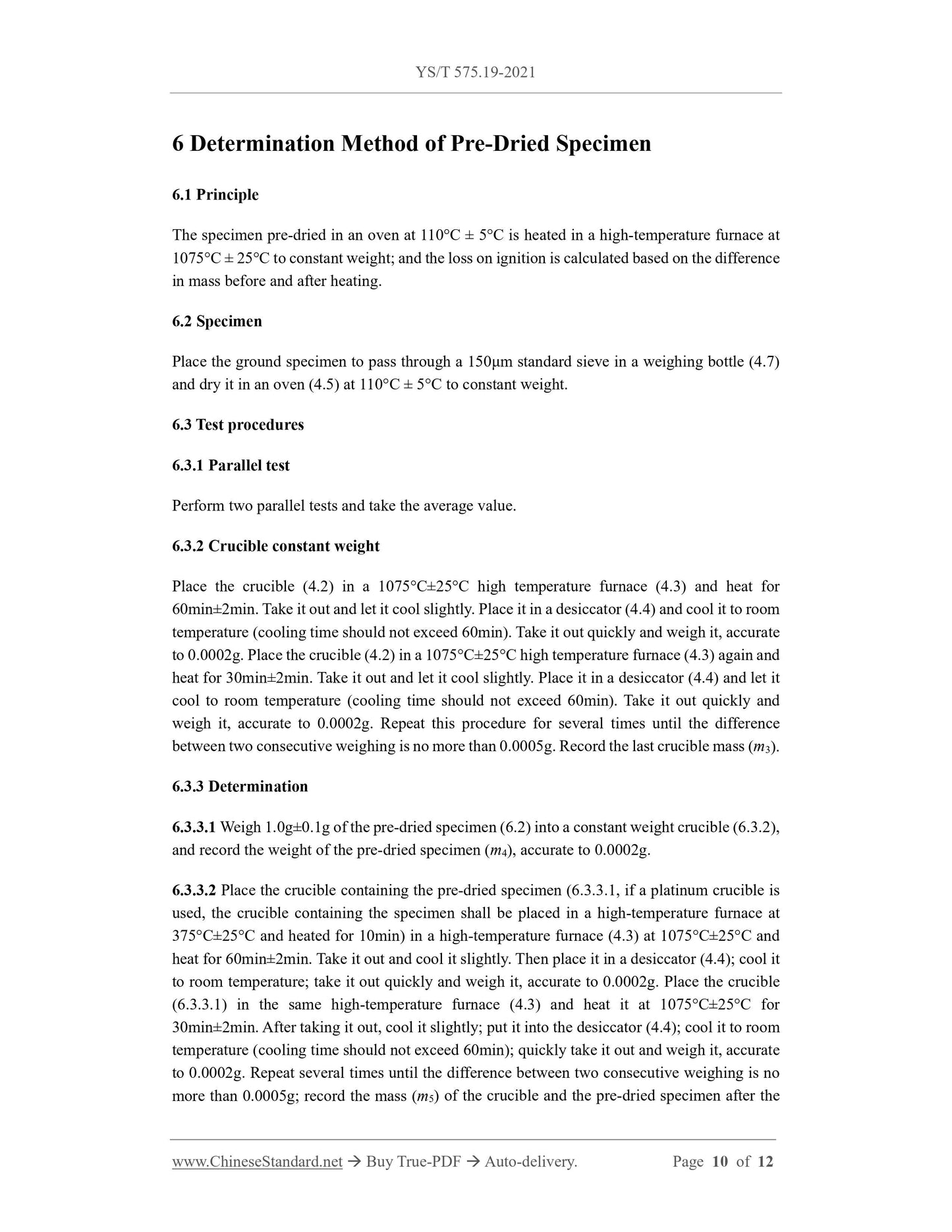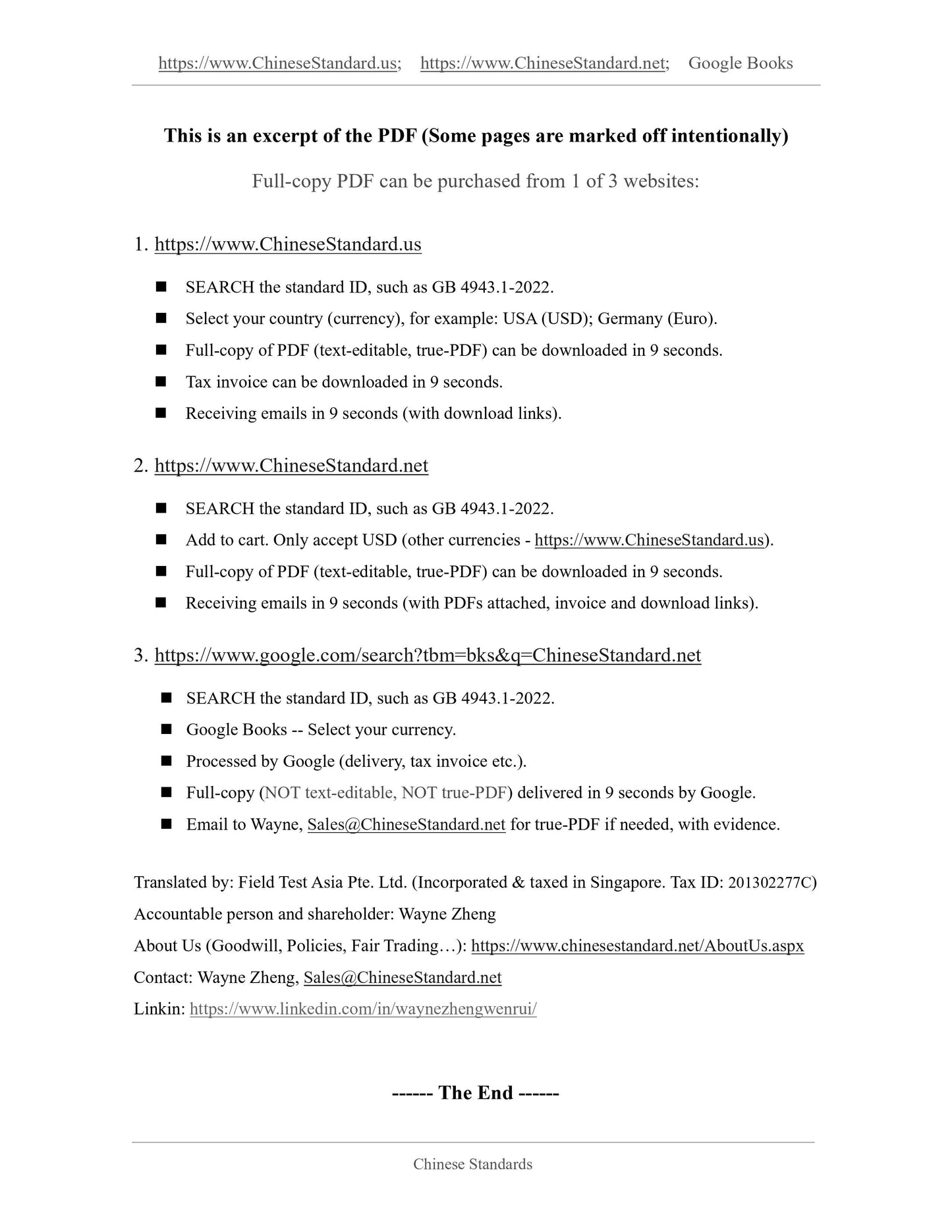1
/
of
6
PayPal, credit cards. Download editable-PDF and invoice in 1 second!
YS/T 575.19-2021 English PDF (YST575.19-2021)
YS/T 575.19-2021 English PDF (YST575.19-2021)
Regular price
$155.00 USD
Regular price
Sale price
$155.00 USD
Unit price
/
per
Shipping calculated at checkout.
Couldn't load pickup availability
Delivery: 3 seconds. Download true-PDF + Invoice.
Get QUOTATION in 1-minute: Click YS/T 575.19-2021
Historical versions: YS/T 575.19-2021
Preview True-PDF (Reload/Scroll if blank)
YS/T 575.19-2021: Methods for chemical analysis of bauxite - Part 19: Determination of loss on ignition - Gravimetric method
YS/T 575.19-2021
YS
NONFERROUS METAL INDUSTRY STANDARD
OF THE PEOPLE’S REPUBLIC OF CHINA
ICS 71.040.40
CCS H 30
Replacing YS/T 575.19-2007
Methods for Chemical Analysis of Bauxite – Part 19:
Determination of Loss on Ignition – Gravimetric Method
ISSUED ON: MARCH 05, 2021
IMPLEMENTED ON: JULY 1, 2021
Issued by: Ministry of Industry and Information Technology of the People’s
Republic of China.
Table of Contents
Foreword ... 3
Introduction ... 6
1 Scope ... 7
2 Normative References ... 7
3 Terms and Definitions ... 7
4 Apparatus ... 8
5 Air Balance Wet Water Correction Method ... 8
6 Determination Method of Pre-Dried Specimen ... 10
7 Precision ... 11
8 Test Report ... 11
Methods for Chemical Analysis of Bauxite – Part 19:
Determination of Loss on Ignition – Gravimetric Method
Warning - People who use this Document shall have practical experience in formal
laboratory work. This Document does not point out all possible safety issues. Users are
responsible for taking appropriate safety and health measures and ensuring that the
conditions stipulated by relevant national laws and regulations are met.
1 Scope
This Document specifies the method for determining the loss on ignition in bauxite ores.
This Document is applicable to the determination of the loss on ignition in bauxite ores, with a
determination range of 10.00% ~ 30.00%. Other types of aluminosilicates such as clay and
kaolin can be used for reference.
2 Normative References
The provisions in following documents become the essential provisions of this Document
through reference in this Document. For the dated documents, only the versions with the dates
indicated are applicable to this Document; for the undated documents, only the latest version
(including all the amendments) is applicable to this Document.
GB/T 8170 Rules of rounding off for numerical values and expression and judgement of
limiting values
YS/T 575.20 Methods for chemical analysis of bauxite - Part 20: Preparation of pre-dried
sample
YS/T 575.22 Methods for chemical analysis of bauxite - Part 22: Determination of
hydroscopic moisture - Gravimetric method
3 Terms and Definitions
For the purposes of this Document, there are no terms and definitions apply.
4 Apparatus
4.1 Plate: flat bottom, the plate bottom area shall be no greater than 100 cm2.
4.2 Crucible: platinum crucible or porcelain crucible, diameter is about 30 mm, height is about
45 mm. The porcelain crucible shall be burned in a high temperature furnace at 1075°C ± 25°C
for at least 3 h before the first use.
4.3 High-temperature furnace: the temperature can be controlled at 1075°C ± 25°C.
4.4 Dryer: containing activated alumina (shall be heated at 300°C ± 10°C for 5 h before use) or
color-changing silica gel (shall be heated at 120°C ± 5°C for 4 h before use).
4.5 Oven: the temperature can be controlled at 110°C ± 5°C; and air flow shall be ensured in
the oven.
4.6 Analytical balance: the actual graduation value is 0.0001g.
4.7 Weighing bottle: with lid, large enough to hold the required specimen volume.
5 Air Balance Wet Water Correction Method
5.1 Principle
Weigh two specimens after air balance; one for air balance wet water content measurement, the
other for loss on ignition measurement; use air balance wet water content correction to calculate
loss on ignition.
5.2 Specimen
Take about 10 g of the sample that has passed through a 150μm standard sieve; spread it evenly
on the bottom of the plate (4.1); and balance it in the air for more than 2 h.
5.3 Test procedures
5.3.1 Parallel test
Perform two parallel tests and take the average value.
5.3.2 Constant weight of crucible
5.3.2.1 Place the crucible (4.2) in a high-temperature furnace (4.3) at 1075°C ±25°C; heat and
burn for 60 min ±2 min. Take it out and put it in a desiccator (4.4); cool it to room temperature
(cooling time should not exceed 60 min); quickly take it out and weigh it, accurate to 0.0002 g.
6 Determination Method of Pre-Dried Specimen
6.1 Principle
The specimen pre-dried in an oven at 110°C ± 5°C is heated in a high-temperature furnace at
1075°C ± 25°C to constant weight; and the loss on ignition is calculated based on the difference
in mass before and after heating.
6.2 Specimen
Place the ground specimen to pass through a 150μm standard sieve in a weighing bottle (4.7)
and dry it in an oven (4.5) at 110°C ± 5°C to constant weight.
6.3 Test procedures
6.3.1 Parallel test
Perform two parallel tests and take the average value.
6.3.2 Crucible constant weight
Place the crucible (4.2) in a 1075°C±25°C high temperature furnace (4.3) and heat for
60min±2min. Take it out and let it cool slightly. Place it in a desiccator (4.4) and cool it to room
temperature (cooling time should not exceed 60min). Take it out quickly and weigh it, accurate
to 0.0002g. Place the crucible (4.2) in a 1075°C±25°C high temperature furnace (4.3) again and
heat for 30min±2min. Take it out and let it cool slightly. Place it in a desiccator (4.4) and let it
cool to room temperature (cooling time should not exceed 60min). Take it out quickly and
weigh it, accurate to 0.0002g. Repeat this procedure for several times until the difference
between two consecutive weighing is no more than 0.0005g. Record the last crucible mass (m3).
6.3.3 Determination
6.3.3.1 Weigh 1.0g±0.1g of the pre-dried specimen (6.2) into a constant weight crucible (6.3.2),
and record the weight of the pre-dried specimen (m4), accurate to 0.0002g.
6.3.3.2 Place the crucible containing the pre-dried specimen (6.3.3.1, if a platinum crucible is
used, the crucible containing the specimen shall be placed in a high-temperature furnace at
375°C±25°C and heated for 10min) in a high-temperature furnace (4.3) at 1075°C±25°C and
heat for 60min±2min. Take it out and cool it slightly. Then place it in a desiccator (4.4); cool it
to room temperature; take it out quickly and weigh it, accurate to 0.0002g. Place the crucible
(6.3.3.1) in the same high-temperature furnace (4.3) and heat it at 1075°C±25°C for
30min±2min. After taking it out, cool it slightly; put it into the desiccator (4.4); cool it to room
temperature (cooling time should not exceed 60min); quickly take it out and weigh it, accurate
to 0.0002g. Repeat several times until the difference between two consecutive weighing is no
more than 0.0005g; record the mass (m5) of the crucible and the pre-dried specimen after the
Get QUOTATION in 1-minute: Click YS/T 575.19-2021
Historical versions: YS/T 575.19-2021
Preview True-PDF (Reload/Scroll if blank)
YS/T 575.19-2021: Methods for chemical analysis of bauxite - Part 19: Determination of loss on ignition - Gravimetric method
YS/T 575.19-2021
YS
NONFERROUS METAL INDUSTRY STANDARD
OF THE PEOPLE’S REPUBLIC OF CHINA
ICS 71.040.40
CCS H 30
Replacing YS/T 575.19-2007
Methods for Chemical Analysis of Bauxite – Part 19:
Determination of Loss on Ignition – Gravimetric Method
ISSUED ON: MARCH 05, 2021
IMPLEMENTED ON: JULY 1, 2021
Issued by: Ministry of Industry and Information Technology of the People’s
Republic of China.
Table of Contents
Foreword ... 3
Introduction ... 6
1 Scope ... 7
2 Normative References ... 7
3 Terms and Definitions ... 7
4 Apparatus ... 8
5 Air Balance Wet Water Correction Method ... 8
6 Determination Method of Pre-Dried Specimen ... 10
7 Precision ... 11
8 Test Report ... 11
Methods for Chemical Analysis of Bauxite – Part 19:
Determination of Loss on Ignition – Gravimetric Method
Warning - People who use this Document shall have practical experience in formal
laboratory work. This Document does not point out all possible safety issues. Users are
responsible for taking appropriate safety and health measures and ensuring that the
conditions stipulated by relevant national laws and regulations are met.
1 Scope
This Document specifies the method for determining the loss on ignition in bauxite ores.
This Document is applicable to the determination of the loss on ignition in bauxite ores, with a
determination range of 10.00% ~ 30.00%. Other types of aluminosilicates such as clay and
kaolin can be used for reference.
2 Normative References
The provisions in following documents become the essential provisions of this Document
through reference in this Document. For the dated documents, only the versions with the dates
indicated are applicable to this Document; for the undated documents, only the latest version
(including all the amendments) is applicable to this Document.
GB/T 8170 Rules of rounding off for numerical values and expression and judgement of
limiting values
YS/T 575.20 Methods for chemical analysis of bauxite - Part 20: Preparation of pre-dried
sample
YS/T 575.22 Methods for chemical analysis of bauxite - Part 22: Determination of
hydroscopic moisture - Gravimetric method
3 Terms and Definitions
For the purposes of this Document, there are no terms and definitions apply.
4 Apparatus
4.1 Plate: flat bottom, the plate bottom area shall be no greater than 100 cm2.
4.2 Crucible: platinum crucible or porcelain crucible, diameter is about 30 mm, height is about
45 mm. The porcelain crucible shall be burned in a high temperature furnace at 1075°C ± 25°C
for at least 3 h before the first use.
4.3 High-temperature furnace: the temperature can be controlled at 1075°C ± 25°C.
4.4 Dryer: containing activated alumina (shall be heated at 300°C ± 10°C for 5 h before use) or
color-changing silica gel (shall be heated at 120°C ± 5°C for 4 h before use).
4.5 Oven: the temperature can be controlled at 110°C ± 5°C; and air flow shall be ensured in
the oven.
4.6 Analytical balance: the actual graduation value is 0.0001g.
4.7 Weighing bottle: with lid, large enough to hold the required specimen volume.
5 Air Balance Wet Water Correction Method
5.1 Principle
Weigh two specimens after air balance; one for air balance wet water content measurement, the
other for loss on ignition measurement; use air balance wet water content correction to calculate
loss on ignition.
5.2 Specimen
Take about 10 g of the sample that has passed through a 150μm standard sieve; spread it evenly
on the bottom of the plate (4.1); and balance it in the air for more than 2 h.
5.3 Test procedures
5.3.1 Parallel test
Perform two parallel tests and take the average value.
5.3.2 Constant weight of crucible
5.3.2.1 Place the crucible (4.2) in a high-temperature furnace (4.3) at 1075°C ±25°C; heat and
burn for 60 min ±2 min. Take it out and put it in a desiccator (4.4); cool it to room temperature
(cooling time should not exceed 60 min); quickly take it out and weigh it, accurate to 0.0002 g.
6 Determination Method of Pre-Dried Specimen
6.1 Principle
The specimen pre-dried in an oven at 110°C ± 5°C is heated in a high-temperature furnace at
1075°C ± 25°C to constant weight; and the loss on ignition is calculated based on the difference
in mass before and after heating.
6.2 Specimen
Place the ground specimen to pass through a 150μm standard sieve in a weighing bottle (4.7)
and dry it in an oven (4.5) at 110°C ± 5°C to constant weight.
6.3 Test procedures
6.3.1 Parallel test
Perform two parallel tests and take the average value.
6.3.2 Crucible constant weight
Place the crucible (4.2) in a 1075°C±25°C high temperature furnace (4.3) and heat for
60min±2min. Take it out and let it cool slightly. Place it in a desiccator (4.4) and cool it to room
temperature (cooling time should not exceed 60min). Take it out quickly and weigh it, accurate
to 0.0002g. Place the crucible (4.2) in a 1075°C±25°C high temperature furnace (4.3) again and
heat for 30min±2min. Take it out and let it cool slightly. Place it in a desiccator (4.4) and let it
cool to room temperature (cooling time should not exceed 60min). Take it out quickly and
weigh it, accurate to 0.0002g. Repeat this procedure for several times until the difference
between two consecutive weighing is no more than 0.0005g. Record the last crucible mass (m3).
6.3.3 Determination
6.3.3.1 Weigh 1.0g±0.1g of the pre-dried specimen (6.2) into a constant weight crucible (6.3.2),
and record the weight of the pre-dried specimen (m4), accurate to 0.0002g.
6.3.3.2 Place the crucible containing the pre-dried specimen (6.3.3.1, if a platinum crucible is
used, the crucible containing the specimen shall be placed in a high-temperature furnace at
375°C±25°C and heated for 10min) in a high-temperature furnace (4.3) at 1075°C±25°C and
heat for 60min±2min. Take it out and cool it slightly. Then place it in a desiccator (4.4); cool it
to room temperature; take it out quickly and weigh it, accurate to 0.0002g. Place the crucible
(6.3.3.1) in the same high-temperature furnace (4.3) and heat it at 1075°C±25°C for
30min±2min. After taking it out, cool it slightly; put it into the desiccator (4.4); cool it to room
temperature (cooling time should not exceed 60min); quickly take it out and weigh it, accurate
to 0.0002g. Repeat several times until the difference between two consecutive weighing is no
more than 0.0005g; record the mass (m5) of the crucible and the pre-dried specimen after the
Share
